Closure for 2019 California Offshore Race Week
Published on June 2nd, 2019
The fifth edition of California Offshore Race Week came to a close with the SoCal 300 which attracted a record 38 boats in 7 classes. Extending from Santa Barbara to San Diego, the 245nm course concluded the circuit that began with the Spinnaker Cup on May 25 (San Francisco to Monterey; 88nm) followed by the Coastal Cup on May 27 (Monterey to Santa Barbara; 204nm).
New this year, the California Offshore Week included a fourth component for the fastest boats – the CA 500.
Many Southern California boats use the race as a Transpac Race qualifier (must sail a 150nm race or passage in year prior to Transpac with a specified number of the same crew on board). Additionally, teams from Northern California make their way through the CA Offshore Race Week and conclude the series with the SoCal 300.
This year, the race also had several international teams, including first to finish Alive (Phillip Turner’s RP 66) along with first in Class A and first overall corrected time Maverick (Quentin Stewart’s Infiniti 46R). Also there was Taurus, Barrington Darcy’s Farr 40, which sailed the CORW series but had to retire prior to the SoCal 300 with an issue with their boat.
Next up for Alive and Maverick is the Transpac race, where they will compete in Division 1 against the heavy hitters such as record holder Comanche and two-time Barn Door winner Rio100.
The Santa Cruz 50/52 class has been a mainstay in the CA Offshore Race Week since the beginning. Dave MacEwen’s Lucky Duck and Bill Helvestine’s Deception have raced all four of the series since it began in 2016. This year in the Santa Cruz class, the series belonged to Michael Moradzadeh’s Santa Cruz 50 Oaxaca, who was first in the Spinnaker Cup, 2nd in Coastal Cup, 1st in the SoCal 300, and 1st in the Series for the SC class.
Michael Moradzadeh: “The host clubs made everyone feel like a winner, but we were exceptionally pleased to collect trophies at each stop. The courses and conditions provided great opportunity for the Santa Cruz 50 and 52s to cash in on preparation and practice.
“Some exceptional crew members (Liz Baylis, Dee Caffari, and more) allowed us to sail to our potential. Even so, we were thrilled to wake up to discover we had corrected out at the top of the fleet [for the Series].”
The SoCal 300 Class B winner was John Raymont’s Andrews 40 Fast Exit, in a highly competitive 11 boat class. Many of the same boats from Class B (Zero Gravity, Velvet Hammer, Cipango, Bretwalda3) will face off again in Transpac Division 3.
Zachery Anderson’s J/125 Velvet Hammer had an incredible week competing in the full 3-race series and winning the overall CA Offshore Race Week title. They were in the series class against Maverick and Alive, chasing them down the coast all week long. In the end, the title was theirs as they had the best corrected time in the SoCal 300 of all series participants.
Zachery Anderson: “The whole race week was ideal. Each race of the series provided different challenges and conditions. It was special to leave the San Francisco Bay and sail down the coast with the whales.
“For us, Coastal Cup was the highlight. The conditions were perfect for the J/125. We were up on the step for hours. It was spectacular to have sustained boat speeds in the teens and twenties all night.
“For the SoCal 300 we transitioned to 5 crew in the prep for our Transpac run this summer. The race was like a mini Transpac, big breeze and reaching off the coast then a nice downwind run. We went into this race as a tune up for Transpac and the first major offshore racing we have done on the J/125.
“I am so proud of the Velvet Hammer crew was able to win the CORW. We are going into Transpac with a full head of steam.”
Don Jesberg raced the CA Offshore Race Week for the first time this year in his Cal 40 Viva and racked up the trophies all week long. Viva won their class in the Spinnaker Cup, Coastal Cup, SoCal 300, and in the full CORW Series, and will line up against six other Cal 40s in this summer’s Transpac race.
Don Jesberg: “These regattas were our first races with Viva after acquiring the boat (originally Warpath) in November 2017. We have rebuilt the entire boat.
“I last raced a Cal 40 in the 2005 Transpac (Ralphie). I grew up sailing in various Cal boats. My father had a Cal 33 from 1972 to 1986. We raced that to Hawaii 3 times.
“The CORW series was an excellent opportunity to experience every possible wind and sea condition that we might experience in the upcoming Transpac 2019. We prefer the windy conditions of Pt Conception to the light air finishes in Santa Barbara and San Diego. The hospitality all week was outstanding. Thank you to all the clubs involved.”
Class D was won by Joe Markee’s Swede 34 Ohana, who came back in the final leg to edge out the Sparkman Stephens 67 Chubasco for the win.
The Hobie 33s were the stars of the show in Class E, led by Bill Hardesty (Sizzle) winning the class, followed by Rick Yabsley’s Captain Sluggo in 2nd and Lemke/Lawson’s Dark Star in 4th.
There were two Beneteau boats that sailed under an ORR-ez certificate, Macondo and Sonrisa, tailing the fleet down the course. Sonrisa finished in the afternoon of June 1 and joined the awards party just in time to collect their trophy. The crew of Macondo raced the first two legs before a Coast Guard rescue helped recover a severely ill crew member (see rescue mission). The Coast Guard mission was successful, and Macondo continued to race for several hours before getting stuck in the light winds on the last leg and retiring to return to Marina del Rey.
The SoCal 300 is unique in the way it is scored using 3 separate legs plus the full start to finish being the 4th leg for scoring purposes. The original idea was to take the differing conditions of the race from Santa Barbara to the islands, the run down to the turning buoy and the race to the finish and score the competition as 3 legs plus the 4th leg being the full start to finish of the race (worth 1.5 points). So a “perfect” score would be 1 + 1 + 1 + 1.5 = 4.5 points.
Looking at the race results over the 5 year history, the only boat that didn’t win the race despite having the best corrected time from start to finish (leg 4) was in 2017 when Santa Cruz 52 Lucky Duck came in 3rd. The scored a 12 on Leg 1, and then made up all of the time over the rest of the course and had the best corrected time at the finish. But due to the 12 points, ended up 3rd Overall.
All other years the race winner was the boat with the best corrected time from start to finish (so same as traditional scoring). Many competitors enjoy the leg scoring concept, seeing how they perform on different legs with their unique conditions and racing lines, so expect to see this scoring concept continue.
One way that this scoring is made possible is the technology of the YB Tracking race trackers. All four races in the Race Week were tracked live with 15 minute updates. San Diego Yacht Club has been working with YB Tracking for almost a decade, providing race trackers for all boats racing in the Islands Race, SoCal 300, and Puerto Vallarta Race.
The trackers have the ability to ping a boat’s crossing of a GPS line, so all scoring uses the location and timing pings from a boat’s tracker to determine the leg finish/start times. The competitors are asked to document their own perceived crossings for verification and backup in case there is an issue with the tracker on board.
Over the last few years, the concept has been proven successful and will continue to allow offshore racing to dial in the courses including virtual finish lines farther out to sea, rather than relying on marks or buoys.
SD Boatworks’ David and Julie Servais were integral in creating the SoCal 300 in 2015 on behalf of San Diego Yacht Club, and continue to support the event as a sponsor in 2019. SD Boatworks will also be supporters of the Transpac Race this summer.
David Servais: “We are so thrilled to see the SoCal 300 continue to grow. From its inception in 2015, to its incorporation into Offshore Race Week, this race is quickly becoming a world class event. As a lead in to Transpac there is no better way to test your equipment and your crew.”
The SoCal 300 was sailed concurrently with the CA 500, in its inaugural running. Three MOD70s (PowerPlay, Argo, and Maserati) started the race off of St. Francis Yacht Club, sailed under the Golden Gate bridge, around the Farallon Islands and blasted down the coast to the finish in San Diego.
The trimarans, who started at the same time as the SoCal 300 racers on May 30, just 250 miles to the north, caught up the SoCal 300 fleet before sunrise the following day, about 14 hours after the starts.
PowerPlay and Argo sailed virtually the same race for the first 60%, and were neck and neck past Santa Barbara. As they made the approach to the turning buoy southeast of San Clemente, PowerPlay finally started to pull away, putting a few miles between them and Argo that just couldn’t be made up through the light wind final leg approach to the San Diego finish.
The Maserati team took a different line, heading closer to shore on the downwind leg after a collision with an unidentified floating object soon after the start and had damage to the right side rudder.
“The rudders’ anti-impact system worked very well,” said Giovanni Soldini, “without it we would’ve lost the rudder completely. The only damaged piece is the pivot attached to the steering rod, which is a small detail. Because of this we couldn’t operate the rudder anymore during the race, but it will be a very easy thing to fix.”
The Italian Team was delayed by the damaged rudder and by other impacts with algae and floating objects, so Giovanni Soldini and his Team tried a different route. “We tried a course closer to the coast to compensate the disadvantage we had because of the rudder: in those conditions, if we had set the same course as our competitors, we would’ve only followed them from behind without regaining miles. We were hoping to find a better gybing angle shown in the weather forecasts, which unfortunately turned out to be inaccurate.”
PowerPlay received the perpetual trophy developed by San Diego Yacht Club several years ago as a way to commemorate the accomplishments of the multihulls even when they didn’t have direct competition. HL Enloe’s Orma 60 Mighty Merloe would often sail the races as the lone multihull or against one other, setting course records all over the west coast. The trophy is awarded to a record setting performance by a multihull on any SDYC-hosted coastal or offshore distance race.
The three MOD70s from the US, UK, and Italy will tune their boats, practice with their teams in preparation for the rematch in the 2019 Transpac Race this July. The multihull division will start on July 13th, with their eyes on Mighty Merloe’s elapsed time record set in 2017 of 4 days, 6:32:30.
Event details – Entry list – Results – Tracker
Photo Galleries: SoCal 300 – CA 500
Current SoCal 300 Records:
Monohull Elapsed Time: 2015: Rio100: 16:26:58
Multihull Elapsed Time: 2018: Mighty Merloe: 15:22:15
Current CA 500 Record:
Multihull Elapsed Time: 2019: PowerPlay: 29:02:24
The fifth edition of California Offshore Race Week once again connects three distances races into a full offshore race week series. The first stage is the Spinnaker Cup on May 25 (San Francisco to Monterey; 88nm) followed by the Coastal Cup on May 27 (Monterey to Santa Barbara; 204nm) and the SoCal 300 on May 30 (Santa Barbara to San Diego; 245nm).
New this year, the California Offshore Week includes a fourth component for the fastest boats – the CA 500 from San Francisco to San Diego on May 30. Originally conceived by Manouch Moshayedi who owns Rio100, the big monohulls couldn’t rally interest but three MOD70s will be using the course as preparation for the 2019 Transpac Race in July.
Source: Jared Wohlgemuth


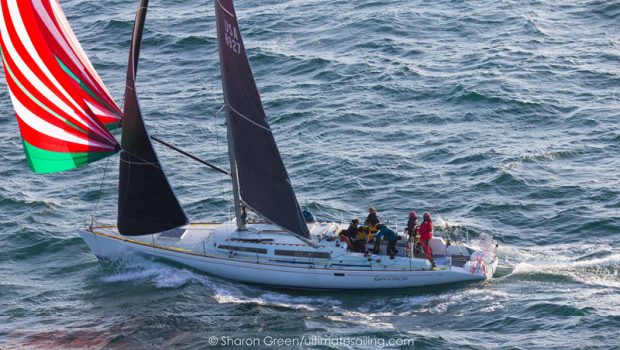


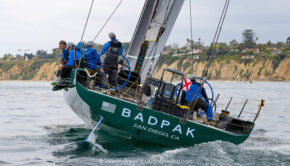
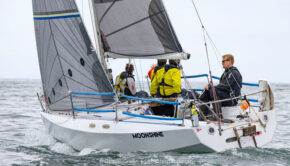
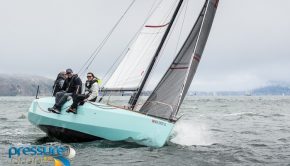
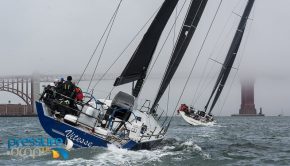
 We’ll keep your information safe.
We’ll keep your information safe.